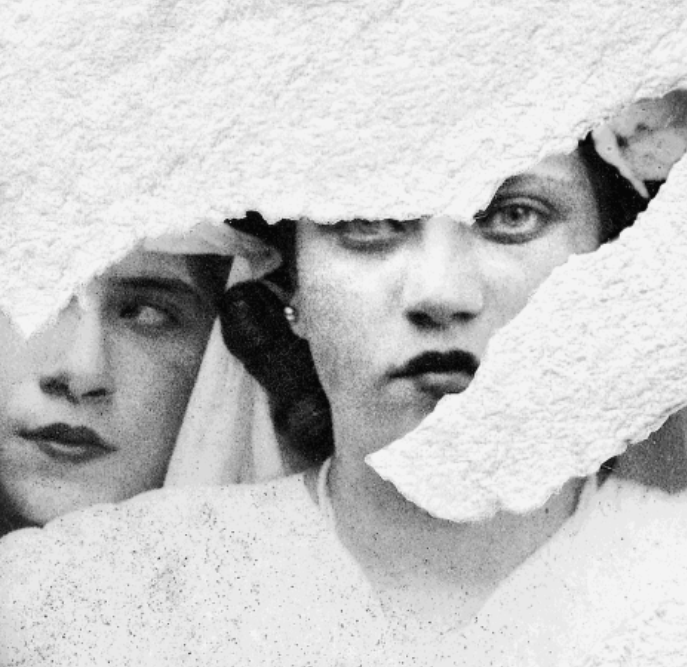DOR GUEZ – DVIR
In “Paper Veil”, Dor Guez brings together recent works alongside earlier pivotal pieces spanning two decades of his practice. This exhibition unfolds as a reflection on fragility, memory, and the complex ways identity is archived—whether through photography, scanography, or the fragile surface of paper.
This exhibition continues Dor Guez’s exploration of displacement and how personal histories are entangled with broader political narratives. Here, the artist sharpens his focus on two recurring motifs: the veil and paper. The veil—whether as fabric, metaphor, or photographic rupture— emerges as a central gesture of concealment: to protect, to mourn, or to resist. Paper, equally fragile and charged, becomes both a material and a metaphor for how identity is held, obscured, and remembered.
The exhibition opens with Samira, a seminal work that marks a key point in Guez’s practice: a torn photograph of his grandparents from the al-Munayer family, taken at their wedding in 1949—the first Palestinian wedding in Lydda after the 1948 war. Guez first exhibited this image twenty years ago, initiating a lifelong project dedicated to his family’s archive and the broader histories of his community. The tear runs directly through the bride’s veil, exposing the inner layers of the photographic paper itself. Here, photography is not merely a tool for documentation but a material embodiment of rupture, survival, and the precarious ways memory is held.
Paper, for Guez, has never been neutral. It holds, it breaks, it carries, it fails. This logic continues in a sculptural photograph suspended from the ceiling: a printed image of a lace curtain once handmade by his grandmother. This curtain, one of the few objects salvaged from the family’s home before their displacement, becomes a poignant trace of what endures. Suspended in space, it becomes a membrane— between interior and exterior, memory and forgetting, visibility and obscurity.
Another new work in the exhibition is based on a portrait of a Palestinian woman, a friend of the artist, photographed twenty years ago in Jerusalem. Her figure oscillates between common imagery of mourning and the iconic depiction of the Virgin Mary as a grieving mother. The photograph is printed as is, as a negative, on a transparent surface, allowing light to pass through and cast a shadow onto a smooth archival paper beneath. Her silhouette undergoes a doubling, shifting from a negative image to a shadow—existing on the boundary between presence and trace, visible and invisible.
In a new series, Guez returns to a tradition practiced in his father’s family, some of whom migrated to France from Tunisia after it was occupied by the Nazis. Photographs depict mirrors draped in white cloth—a gesture shared across cultures as a sign of mourning, sanctity, or transition. In Judaism, as in other traditions, covering can signify grief but also reverence. The veiled mirrors suggest an image that is simultaneously hidden and heightened; absence becomes a presence of its own.
The exhibition also includes Khobiza, a series Guez has been working on for the past two years that documents the wild mallow plant (known as Hubeza in Arabic), which grows abundantly across the Levant
and holds deep cultural significance. Historically used as a bread substitute during times of famine—its name derived from the Arabic word for bread, hubez—Hubeza is both personal and political for Guez, whose family in Gaza relied on the plant for sustenance amid the ongoing war. Echoing the scientific language of herbariums, Guez collects, presses, and dries leaves, stems, and roots, arranging them between sheets before photographing them from above.
Between the late 19th and early 20th century, albums of pressed flowers were popular souvenirs for tourists and pilgrims visiting the Holy Land from Europe and North America. Typically composed of dried petals arranged in floral shapes, these albums recorded collection sites such as “Jerusalem,” “Jericho,” or “Tiberias”—places aligned with a romantic, often religious Western perception of the region. Drawing on extended research into such albums in the American Colony archive in Jerusalem, Guez’s series Lillies of the Field examines the relationship between nature and culture, copy and origin.
The project explores how the local environment has been framed by Orientalist assumptions and adapted to Western aesthetic expectations. Many of the flowers in the albums do not match the locations cited and often include cultivated, non-native species. Botanical names are frequently replaced by literary or biblical references—such as identifying the anemone as the “Lily of the field.” An analysis of color in the flower arrangements reveals how pigments age differently. Guez photographed both the front of each flower arrangement and the reverse side of its wax overlay, which had absorbed the yellow pigment over a century. Aligning the two images, he reimagines the flower image through the lens of time.
The process yielded two photographic series, both in negative. The first simulates photograms of the flowers at a 1:1 scale; the second, by inverting the faded yellow to its complementary hue, resembles large-scale cyanotypes. In these, blank areas mark the original anthocyanin-colored flowers, now faded beneath the yellow residue. By focusing on what remains of the pigment rather than the flowers themselves, Guez challenges hierarchies of authenticity and fabrication.
Throughout Paper Veil, Guez invites us to consider how objects, images, and even plants become vessels for memory, survival, and identity. But more urgently, the exhibition asks: What does it mean to preserve? What is carried forward, and what is left behind? The veil—whether as cloth, paper, or shadow—becomes not only a symbol of mourning but also of care, of resistance, and of the enduring struggle to hold space for narratives that have long been marginalized or erased.
